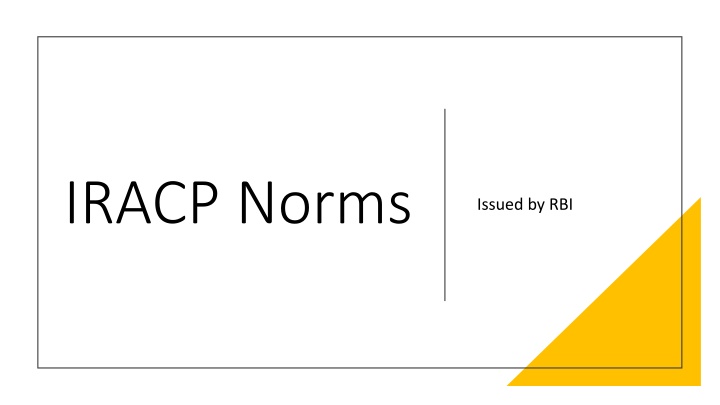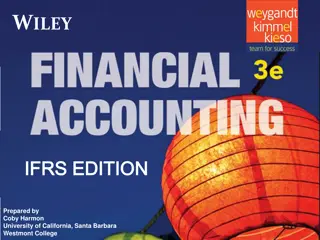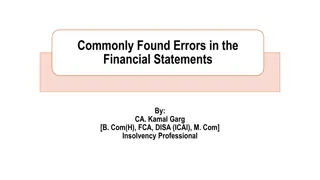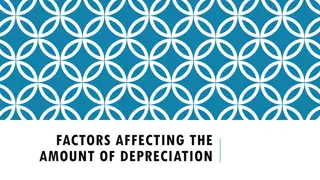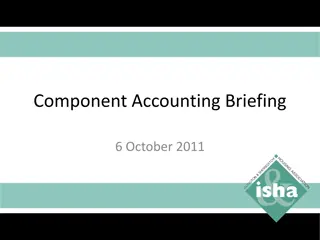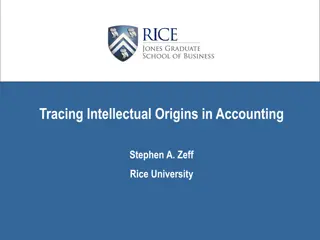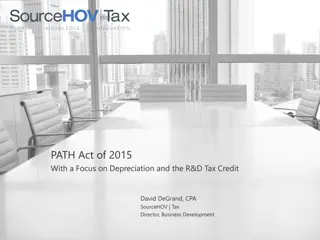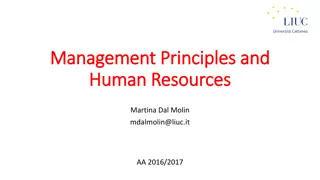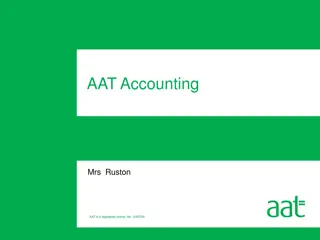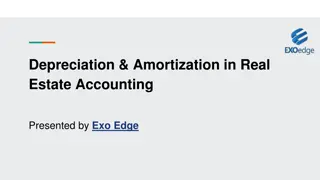Methods of Depreciation in Financial Accounting
Learn about different methods of depreciation including activity, straight-line, and diminishing-charge methods. Understand the concepts and factors involved in depreciation calculations through practical examples.
Download Presentation

Please find below an Image/Link to download the presentation.
The content on the website is provided AS IS for your information and personal use only. It may not be sold, licensed, or shared on other websites without obtaining consent from the author.If you encounter any issues during the download, it is possible that the publisher has removed the file from their server.
You are allowed to download the files provided on this website for personal or commercial use, subject to the condition that they are used lawfully. All files are the property of their respective owners.
The content on the website is provided AS IS for your information and personal use only. It may not be sold, licensed, or shared on other websites without obtaining consent from the author.
E N D
Presentation Transcript
IRACP Norms Issued by RBI
IRACP Norms Income Recognition Asset Provisioning Classification
Can record the income when the income is accrued in standard accounts 1. Accrual Basis Income Recognition 2. Cash Basis in case of NPA
Reversal of Income Other Points related to Income Recognition If any advance, including bills purchased and discounted, becomes interest accrued and credited to income account in the past periods, should be reversed if the same is not realized. This will also apply to Central guaranteed accounts. NPA, the entire Government Appropriation of recovery in NPAs Interest realised on NPAs may be taken to income account provided the credits in the accounts towards interest are not out of fresh/ additional credit facilities sanctioned to the borrower concerned.
Income recognition Interest Application In NPAs, banks to reverse interest already charged and not collected and stop further application of interest. Income recognition policy for loans with moratorium on payment of interest LIs to recognize income on accrual basis for those accounts which continue to be classified as Standard . Same shall be evaluated as per definition of Restructuring (Ref: Para 1 of the Annex-1 of RBI circular on Prudential Framework for Resolution of Stressed Assets dated June 7, 2019) Interest recognized during moratorium (Permitted at the time of sanction of the loan) need not be reversed, if the account turns NPA after the moratorium is over
NPA Nature of Facility Parameters Term Loan Interest and/or instalment of principal remain overdue beyond 90 days Overdraft/ Cash Credit Remains out of order for 90 days Bills Purchased/Discounted Remains overdue beyond 90 days Agriculture Loan (Short Duration Instalment of principal or interest thereon remains overdue for 2 crop seasons Crops) Agriculture Loan (Long Duration Instalment of principal or interest thereon remains overdue for 1 crop seasons Crops) Securitization Transaction Amount of liquidity facility remains outstanding beyond 90 days Overdue receivables representing positive mark-to-market value of a derivative contract Derivative Transactions which remains unpaid beyond 90 days from specified due date for payment
Record of Recovery is the Thumb Rule Availability of security is irrelevant NPA date is very important System based NPAs (30.06.2021) Term Loan : Para 2.1.2(i) of Master Circular Cash Credit / OD NPA when Out of Order Clarification - para 2.2.1 of Master Circular of RBI dated 01.04.2022 Evergreening Inherent weakness Solitary or a few credits before the balance sheet date Regular / ad-hoc limits not reviewed / regularized within 180 days Stock statement older than three months Deemed irregular Early Warning Signals RBI Master Direction updated on July 3, 2017 Non Performing Assets
NPA classification Borrower wise & not Facility wise Accelerated provision in NPA Accounts Direct Doubtful : Security less than 50% Direct Loss : Security less than 10% Provision in respect of Frauds 100% provision over a period not exceeding four quarters from the date of detection Upgradation of NPAs In case of Normal NPAs : Entire arrears of interest and principal In case of Restructured NPAs : Satisfactory Performance during Specified Period NPA regularized after balance sheet date Not to upgrade Non Performing Assets (Cntd.)
Standard Advance To be immediately downgraded as NPA (Applicable to all resolution plans, including those undertaken under IBC) NPAs, upon restructuring, would continue to have the same asset classification Instances of Restructuring Any change in the sanction terms during the tenure of loan except : Restructuring of Advance (Para 16) Change in DCCO in respect of infra & non-infra projects (Para 4.2.15 of RBI Master Circular) Change in MCLR / Floating rate Change in ROI due to internal / external credit rating Specific Forbearance by RBI : e.g. COVID-19 relief package, MSME One time restructuring etc. Interchangeability in line with sanction terms as per original sanction Restructuring in case of Natural Calamities (RBI Master Direction dated 17.10.2018
MSMEs wherein exposure is less than Rs. 25 Crore Satisfactory Performance during Specified Period Satisfactory Performance : No overdue for more than 30 days Specified Period : One year from the date of payment of interest / principal whichever is later Other than MSME : Exposure upto Rs. 100 Crore Satisfactory Performance during the period from the date of implementation of the RP upto the date by which at least 10% of the outstanding is paid Satisfactory Performance : Borrower is not in default at any time during the period Exposure above Rs. 100 Crore : (Additional Requirement) Should be atleast rated as investment grade (BBB- or better) Upgradation - Restructured Accounts
Classification of Advances / Assets Standard Assets Sub-Standard Assets Doubtful Assets Loss Assets Does disclose problems not any Loss identified by : Remained NPA Remained in the sub-standard category period of months for a period for a >12 1. The bank less than or Does not carry more normal risk equal to 12 than 2. The internal or external auditors Collection liquidation in full is improbable questionable & months highly 3. inspection The RBI Not a non performing asset or
PATTERN TO BE FOLLOWED FOR DEGRADING ASSET IS AS PER FLOW OF CLASSIFICATION - SUB-STANDARD Down- gradation DOUBTFUL D1,D2,D3 LOSS
In certain cases, the same can directly be classified to Doubtful / Loss asset category 1. If erosion in value of securities is more than 50% , then asset will be classified to Doubtful Category 2. If erosion in value of securities is more than 90% or fraud case , then asset will be classified to Loss Asset
Upgradation Only option is to Standard account from any of the categories i.e., a step-by-step ladder not be followed at the time of upgrading the account. Only upon receipt of entire arrears of interest and principal, account should be upgraded. With regard to upgradation of accounts classified as NPA due to restructuring, non-achievement of DCCO, the instruction as specified for such cases shall continue to be applicable. Where the LIs has multiple exposure : Nooverdue status needs to be achieved with reference to all the exposures of borrower. One NPA & other SMA is not permitted.
Treatment of Bill Discounting under LC The bills discounted under LC favoring a borrower may not be classified as a Non- performing assets (NPA), when any other facility granted to the borrower is classified as NPA. However, in case documents under LC are not accepted on presentation or the payment under the LC is not made on the due date by the LC issuing bank for any reason and the borrower does not immediately make good the amount disbursed as a result of discounting of concerned bills, the outstanding bills discounted will immediately be classified as NPA with effect from the date when the other facilities had been classified as NPA.
Provisioning norms - Standard Assets Standard Assets Loan Category % Farm Credit to agricultural activities and Small and Micro Enterprises (SMEs) sectors 0.25 Commercial Real Estate (CRE) Sector 1.00 Commercial Real Estate Residential Housing Sector (CRE - RH) 0.75 All other loans and advances 0.40 The provisions towards Standard Assets need not be netted from gross advances but shown separately as 'Contingent Provisions against Standard Assets' under 'Other Liabilities and Provisions Others' in Schedule 5 of the balance sheet.
Provisioning norms Sub - Standard Assets 1 2 A general provision of 15 percent on total outstanding should be made without making any allowance for ECGC guarantee cover and securities available. The unsecured exposures which are identified as substandard would attract additional provision of 10 per cent, i.e., a total of 25 per cent on the outstanding balance.
Provisioning Norms Doubtful Assets 100 percent of the extent to which the advance is Period for which the advance has remained in doubtful category not covered by the realizable value of the security to % which the bank has a valid recourse, and the realizable value is estimated on a realistic basis. Regarding the secured portion, provision may be Upto 1 Year 25 made on the following basis, at the rates ranging from 25 percent to 100 percent of the secured 1-3 Year 40 portion depending upon the period for which the More than 3 Year 100 asset has remained doubtful:
Thank You CA Hitesh Pomal M: 98240 49402
